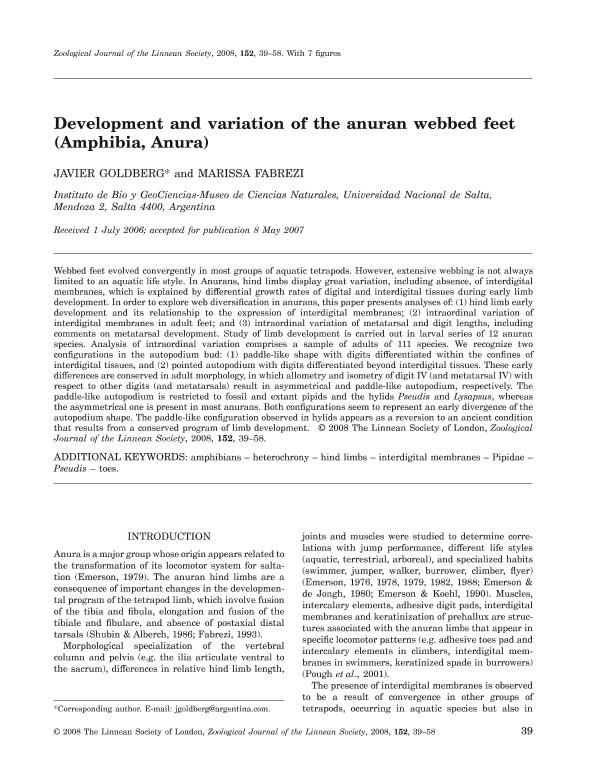Artículo
Development and variation of the anuran webbed feet (Amphibia, Anura)
Fecha de publicación:
01/2008
Editorial:
Oxford University Press
Revista:
Zoological Journal of the Linnean Society
ISSN:
0024-4082
Idioma:
Inglés
Tipo de recurso:
Artículo publicado
Clasificación temática:
Resumen
Webbed feet evolved convergently in most groups of aquatic tetrapods. However, extensive webbing is not always limited to an aquatic life style. In Anurans, hind limbs display great variation, including absence, of interdigital membranes, which is explained by differential growth rates of digital and interdigital tissues during early limb development. In order to explore web diversification in anurans, this paper presents analyses of: (1) hind limb early development and its relationship to the expression of interdigital membranes; (2) intraordinal variation of interdigital membranes in adult feet; and (3) intraordinal variation of metatarsal and digit lengths, including comments on metatarsal development. Study of limb development is carried out in larval series of 12 anuran species. Analysis of intraordinal variation comprises a sample of adults of 111 species. We recognize two configurations in the autopodium bud: (1) paddle‐like shape with digits differentiated within the confines of interdigital tissues, and (2) pointed autopodium with digits differentiated beyond interdigital tissues. These early differences are conserved in adult morphology, in which allometry and isometry of digit IV (and metatarsal IV) with respect to other digits (and metatarsals) result in asymmetrical and paddle‐like autopodium, respectively. The paddle‐like autopodium is restricted to fossil and extant pipids and the hylids Pseudis and Lysapsus, whereas the asymmetrical one is present in most anurans. Both configurations seem to represent an early divergence of the autopodium shape. The paddle‐like configuration observed in hylids appears as a reversion to an ancient condition that results from a conserved program of limb development.
Palabras clave:
Amphibians
,
Heterochrony
,
Hind Limbs
,
Interdigital Membranes
,
Pipidae
,
Pseudis
,
Toes
Archivos asociados
Licencia
Identificadores
Colecciones
Articulos(IBIGEO)
Articulos de INST.DE BIO Y GEOCIENCIAS DEL NOA
Articulos de INST.DE BIO Y GEOCIENCIAS DEL NOA
Citación
Goldberg, Francisco Javier; Fabrezi, Marissa; Development and variation of the anuran webbed feet (Amphibia, Anura); Oxford University Press; Zoological Journal of the Linnean Society; 152; 1; 1-2008; 39-58
Compartir
Altmétricas




